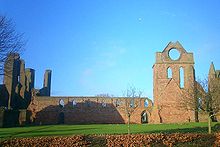Arbroath Abbey
Arbroath Abbey , German Monastery Arbroath , Abbey Arbroath is a former abbey of Benedictine in Arbroath in the Council Area and traditional county of Angus on the east coast of Scotland .
The monastery was founded in 1178 at the instigation of the Scottish King William the Lion by Benedictine monks from the southern Scottish Abbey of Kelso and consecrated in 1197 . Cardinal David Beaton became the last abbot in 1524 .
Arbroath Abbey is a national monument and is administered by the State Monument Protection Agency "Historic Scotland". The striking red sandstone ruins can be visited all year round.
architecture
The monastery was built over a period of over sixty years from red sandstone in the style of the English late Gothic ( "Perpendicular Style": "Vertical Style" ) and with influences of the European Romanesque ( "Norman Style": "Norman Style" ). The triforium is an example of Scottish architecture in the Middle Ages ; it is flanked by two colonnaded towers. The cross-shaped floor plan of the church measures 84 by 49 meters.
The sacristy built in the 15th century , the southern transept with its pointed arched windows (the largest in Scotland), parts of the choir (presbytery) , the southern half of the nave and the ruins of the western towers and western arch are preserved.
The soft sandstone was plastered inside and out . Many of the earlier architectural details have been lost to erosion ; only a few preserved fragments give an approximate impression of the original appearance. The characteristic round window in the south transept was lit at night and served as a beacon for shipping .
Originally the church had a central tower, which was visible from afar and should have served as a landmark for ships.
Only a few of the monastery buildings have survived: the impressive gatehouse, which extends from the south-west corner of the church to a fortified tower on "High Street" in Arbroath, and the abbot's house from the 13th, 15th and 16th centuries, which is the best preserved of its kind in Scotland.
history

King Wilhelm gave the monastery great independence and generously endowed it with, among other things, the income from 24 parishes and with lands in all free cities of Scotland. The monks received market rights and permission to build a port. The English King John Ohneland permitted duty-free trade in the monastery throughout the country with the exception of London .
During the Scottish Reformation the monastery fell into disrepair; its stones were used from 1580 in the construction of buildings in Arbroath. Around 1700 the overall impression was roughly the same as it is today. In 1809 the large round window was restored on the initiative of Robert Stevenson, and in 1815 measures were taken to preserve the remaining monastery ruins.
On April 11, 1951, the police found the " Stone of Scone ", the Scottish coronation stone, stolen from Westminster Abbey in London on December 25, 1950 at the monastery altar in Arbroath .
Efforts have been made since 2005 to include Abbey Abbey as a cultural monument in the “UNESCO World Heritage List” .
Arbroath Declaration
The richest monastery in Scotland at the time became famous for the Declaration of Arbroath , the Scottish Declaration of Independence of April 6th, 1320. Even today, on April 6th, the signing of the Declaration is celebrated with a procession and historical performances.
Burial place
King Wilhelm I was buried in front of the high altar of the monastery church.
Visitor center
A visitor center opened in summer 2001 provides information about the history of the monastery and shows various relics as well as a true-to-scale model of the former building complex . A computer animation shows the monastery during its heyday.
Others
In 1773 the English scholar Samuel Johnson , accompanied by his friend James Boswell, visited the ruins of Arbroath Abbey. In his travelogue A Journey to the Western Isles of Scotland , Johnson dedicated a separate chapter to the ruined abbey. However, Johnson named the place and monastery Aberbrothick .
Web links
- Arbroath Abbey on the website www.undiscoveredscotland.co.uk (English)
- Arbroath Abbey on the website of Historic Scotland (English)
Individual evidence
- ↑ Samuel Johnson: A Journey to the Western Isles of Scotland . with a foreword and comments by Ingrid Kuczynski. 1st edition. No. 1132 . Verlag Philipp Reclam jun., Leipzig 1986, license number 363.340 / 75/86, p. 25th ff .
Coordinates: 56 ° 33 ′ 45 " N , 2 ° 34 ′ 56" W.


